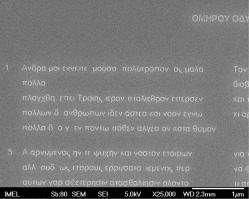Microelectronic Engineering ( IF 2.3 ) Pub Date : 2020-03-02 , DOI: 10.1016/j.mee.2020.111284 Evangelos Gogolides

|
Homer's epic poem Odyssey tells the story of Odysseus voyage back home after the fall of Troy. The 12,110 lines poem is printed with letters at the nanoscale using state-of-the-art electron beam technology by two Greek young researchers Antonis Olziersky and George Papageorgiou. The 303 pages of the poem fit in an area of less than 138μmX184μm or 0.025mm2. The researchers had a formidable time to print the accents and the diacritical marks of the Greek language in the sub 10nm length scale. What are the implications of this work? At this scale one could pack on a 6" wafer approximately 0.7 million books. Google has calculated that the number of books in existence is approximately 130million. Therefore, with 186 wafers one could preserve all the books in existence etched on silicon as a way of world heritage preservation. Applications in the preservation and miniaturization of other forms of colorful art are discussed.
中文翻译:

荷马遇见纳米:运用最先进的纳米技术缩小2700年历史的希腊诗歌
荷马史诗《奥德赛》讲述了特洛伊陷落后奥德修斯远航的故事。两位希腊年轻研究人员Antonis Olziersky和George Papageorgiou使用最先进的电子束技术在12110行诗上用纳米级字母印刷。这首诗的303页适合于小于138μmX184μm或0.025mm2的区域。研究人员花了很长时间在不到10纳米的长度范围内印刷希腊语的重音符号和变音符号。这项工作的意义是什么?在这种规模下,一个人可以在6英寸的晶圆上包装约70万本书。谷歌计算得出,现有的图书数量约为1.3亿册。因此,使用186个晶圆,一个人可以保存所有刻蚀在硅上的书籍,作为一种方法。世界遗产保护。



























 京公网安备 11010802027423号
京公网安备 11010802027423号